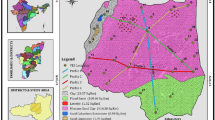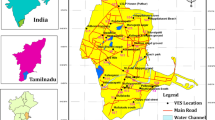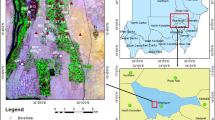Abstract
To delineate spatial extent of seawater intrusion in a small experimental watershed in the coastal area of Byunsan, Korea, electrical resistivity surveys with some evaluation core drillings and chemical analysis of groundwaters were conducted. The vertical electrical sounding (VES) method was applied, which is useful to identify variations in electrical characteristics of layered aquifers. The drilling logs identified a three-layered subsurface including reclamation soil, weathered layer and relatively fresh sedimentary bedrock. The upper two layers are the main water-bearing units in this area. A total of 30 electrical sounding curves corresponded mostly to the H type and they were further divided into three classes: highly conductive, intermediate, and low conductive, according to the observed resistivity values of the most conductive weathered layer. In addition, groundwater samples from 15 shallow monitoring wells were analyzed and thus grouped into two types based on HCO3/Cl and Ca/Na molar ratios with TDS levels, which differentiated groundwaters affected by seawater intrusion from those not or less affected. According to relationships between the three classes of the sounding curves and groundwater chemistry, locations of the monitoring wells with low HCO3/Cl and Ca/Na ionic ratios coincided with the area showing the highly conductive type curve, while those with the high ratios corresponded to the area showing low conductive curve type. Both the low electrical resistivity and the low ionic ratios indicated effects of seawater intrusion. From this study, it was demonstrated that the VES would be useful to delineate seawater intrusion in coastal areas.











Similar content being viewed by others
References
Ataie-Ashtiani B, Volker RE, Lockington DA (1999) Tidal effects on sea water intrusion in unconfined aquifers. J Hydrol 216:17–31
Bear J, Ouazar D, Sorek S, Cheng A, Herrera I (1999) Seawater intrusion in coastal aquifers. Springer, Berlin Heidelberg New York, p 640
Benkabbour B, Toto EA, Fakir Y (2004) Using DC resistivity method to characterize the geometry and the salinity of the Plioquaternary consolidated coastal aquifer of the Mamora plain, Morocco. Environ Geol 45:518–526
Chyba J (1986) Some improvements in the interpretation of vertical electrical sounding curves. Geophys Prospect 34(6):913–922
Cressie N (1988) Spatial prediction and ordinary kriging. Math Geol 20(4):405–421
Edet AE, Okereke CS (2001) A regional study of saltwater intrusion in southeastern Nigeria based on the analysis of geoelectrical and hydrochemical data. Environ Geol 40:1278–1289
Goovaerts P (1997) Geostatistics for natural resources evaluation. Oxford University Press, New York
Hem JD (1989) Study and interpretation of the chemical characteristics of natural water. U.S.G.S. Water-Supply Paper, vol 2254, US Government Printing Office, Washington DC
Isaaks EH, Srivastava RM (1989) Applied geostatistics. Oxford University Press, New York
Kim JH, Kim RH, Lee J, Chang HW (2003) Hydrogeochemical characterization of major factors affecting the quality of shallow groundwater in the coastal area at Kimje in South Korea. Environ Geol 44:478–489
Lee JY, Lee KK (2000) Use of hydrologic time series data for identification of recharge mechanism in a fractured bedrock aquifer system. J Hydrol 229:190–201
Lee JY, Song SH (2006) Evaluation of groundwater quality in coastal areas: implications for sustainable agriculture. Environ Geol (accepted)
MOCT (Ministry of Construction and Transportation), KOWACO (Korea Water Resources Corporation), KIGAM (Korea Institute of Geoscience and Mineral Resources) (2005) Research report on measures for potential groundwater hazard areas. KIGAM, Daejon, p 579
Park SC, Yun ST, Chae GT, Lee SK (2002) Hydrogeochemistry of shallow groundwaters in western coastal area of Korea: a study on seawater mixing in coastal aquifers. J Kor Soc Soil Groundw Environ 7:63–77
Park SC, Yun ST, Chae GT, Yoo IS, Shin KS, Heo CH, Lee SK (2005) Regional hydrochemical study on salinization of coastal aquifers, western coastal area of South Korea. J Hydrol 313:182–194
Richter BC, Kreitler CW (1993) Geochemical techniques for identifying sources of ground-water salinization. CRC Press, p 258
Sherif M, El Mahmoudi A, Garamoon H, Kacimov A, Akram S, Ebraheem A, Shetty A (2006) Geoeletrical and hydrogeochemical studies for delineating seawater intrusion in the outlet of Wadi Ham, UAE. Environ Geol 49:536–551
Telford WM, Geldart LP, Sheriff RE (1990) Applied geophysics, 2nd edn. Cambridge University Press, New York
Todd DK (1980) Groundwater hydrology, 2nd edn. Wiley, New York
USDI (US Department of the Interior) (1974) Earth manual, a water resources technical publication, 2nd edn. US Government Printing Office, Washington DC, pp 14–17
Yaffee R, McGee M (2000) Introduction to time series analysis and forecasting. Academic
Zohdy AAR, Eaton GP, Mabey DR (1974) Application of surface geophysics to ground-water investigation. Techniques of water-resources investigations of the United States Geological Survey, book 2, chap D1, p 66
Acknowledgments
This research was supported by a grant (code number 3-3-2) from Sustainable Water Resources Research Center of 21st Century Frontier Research Program.
Author information
Authors and Affiliations
Corresponding author
Rights and permissions
About this article
Cite this article
Song, SH., Lee, JY. & Park, N. Use of vertical electrical soundings to delineate seawater intrusion in a coastal area of Byunsan, Korea. Environ Geol 52, 1207–1219 (2007). https://doi.org/10.1007/s00254-006-0559-8
Received:
Accepted:
Published:
Issue Date:
DOI: https://doi.org/10.1007/s00254-006-0559-8




